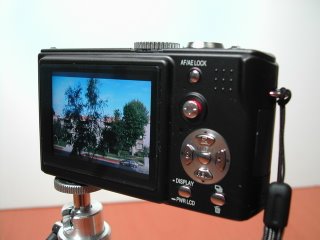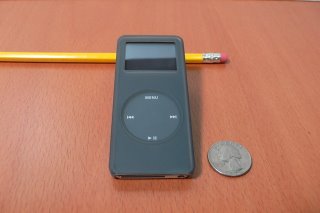For a while I've had a Hauppague PVR 150 card. It lets you watch or record TV from your cable feed. The software that came with it is crude, but works. It has a scheduler, but you have to manually enter the dates for each show you want to record. If you forget it, you miss it.
Everyone I know who has a Tivo says it changes the way you watch TV. You only watch your favorite shows because they are always being recorded, and waiting for you to see. I like that concept, but didn't want to buy another device to do it.
I was looking at alternative software for my PVR card. There are a couple options out there. The one that stood out the most was Beyond TV by Snapstream. Other options are MythTV and SageTV.
BeyondTV has a Tivo-like interface. The only thing missing is the little cartoon character. You can even can use a remote (sold separately), but a wireless keyboard works pretty well too.
It has a built-in TV guide, updated via internet. That works pretty well. You can scroll through channels and get descriptions for anything that's on.
But Beyond TV really shines in how it records. You can either pick shows from teh guide or look them up by name. Then you get to choose whether to record just one episode, new ones, or any ones that happen to play. This is the feature I most wanted from Tivo. It even has rules to determine when it can delete old shows to make room for new ones.
And, I didn't notice this until recently, it records in the background- cool!. The Happauge software always popped up when it was recording.
The interface is very similar most set-top boxes, which makes it a little funny running it on a PC. I could see it would work better if I had it on an extra PC connected to the TV, just like a set-top. I don't know why someone isn't selling it bundled like this. There are bundles available w/software + tv tuner card, but you have to install it yourself.
March 26, 2006
My Yahoo
I've started using My Yahoo as a general contact/info tool. I'm reluctant to use my yahoo email so I don't start attracting huge amounts of spam, which I get on my Hotmail account.
Yahoo has great sync features. I imported everything from my Palm, imported bookmarks from IE, and was able to combine contact lists I've had in separate places. You can export everything too, so you don't feel locked in.
The My Yahoo home page is pretty well layed out. The graphics could be better but it loads fast. I have TV listings, movies, weather reports, plus my favorite RSS feeds from Digg, Techbargains, etc.
I use the Calendar feature alot, for both personal and business schedules. That way I can keep them from conflicting with each other. The calendar is connected to a Tasks List, so you can give things deadlines that show up on the calendar.
I know many people are gaga over anything Google. Some of their stuff is impressive, but the appearance leaves ALOT to be desired. Not that it's sparse- that's what I like about Yahoo versus, say, MSN. It's just really awkward. It's not designed at all. Yahoo got the right combination of form and function.
Yahoo has great sync features. I imported everything from my Palm, imported bookmarks from IE, and was able to combine contact lists I've had in separate places. You can export everything too, so you don't feel locked in.
The My Yahoo home page is pretty well layed out. The graphics could be better but it loads fast. I have TV listings, movies, weather reports, plus my favorite RSS feeds from Digg, Techbargains, etc.
I use the Calendar feature alot, for both personal and business schedules. That way I can keep them from conflicting with each other. The calendar is connected to a Tasks List, so you can give things deadlines that show up on the calendar.
I know many people are gaga over anything Google. Some of their stuff is impressive, but the appearance leaves ALOT to be desired. Not that it's sparse- that's what I like about Yahoo versus, say, MSN. It's just really awkward. It's not designed at all. Yahoo got the right combination of form and function.
March 17, 2006
Buffalo Terastation
After a laptop crash last year, I've become paranoid about losing data. I copy important files to multiple computers and assembled several D.I.Y. external USB HD's (thanks to generous rebates from Western Digital, et al). This distributed method of backup seems alot more reliable than putting everything in one place. But it does make collaborative projects (not to mention finding old files) a little cumbersome.
Fry's Electronics had a rebate on the Buffalo Terastation, a single device for network attached storage (big storage). It's a file server in a box.
It's conveniently accessible from Windows or Mac and can even do FTP. You can set up separate secure shares with user accounts and groups, all set up with a web-based admin page.
You get 4 250GB drives and can configure them in different ways:
-• Standard - 4x 250GB drives (aka Raid-0)
-• Spanning - 1 1TB drive
-• Mirroring - 500MB with a 500MB mirror (aka Raid-1)
-• RAID-5 - 1 750MB drive with parity
Learn about RAID Arrays on the Wikipedia.
The best option (and the default) is Raid-5 which gives you the best of both speed and redundancy. If one drive fails, you can replace it and your files are still intact. And the RAID architecture means you have 4 hard drives working in tandem.
It also has cool lights on the front cover.
Key Features
-• Four operational modes: Standard, Spanning, Mirroring and RAID 5
-• Removable hard drive rack to allow quick swapping of hard drives should a drive fail
-• Advanced RAID system to continually check hard drive performance
-• 10/100/1000 Gigabit Ethernet port and Jumbo Frame capability for higher transfer speeds
-• Heat-release conscious design with smart layout and ventilation supply
-• Memeo™ Easy Backup Software Included
-• Large silent fan to release HDD heat effectively and quietly
-• Four USB 2.0 ports, allowing 4 simultaneous USB connections
-• Built-in print server for sharing and managing a USB printer on the network
-• Built-in FTP server functionality
-• Easy setup wizard and management through intuitive web interface
I'll still use the external drives for backups, but the Terastation will be my new place for active and recent projects.
Fry's Electronics had a rebate on the Buffalo Terastation, a single device for network attached storage (big storage). It's a file server in a box.
It's conveniently accessible from Windows or Mac and can even do FTP. You can set up separate secure shares with user accounts and groups, all set up with a web-based admin page.
You get 4 250GB drives and can configure them in different ways:
-• Standard - 4x 250GB drives (aka Raid-0)
-• Spanning - 1 1TB drive
-• Mirroring - 500MB with a 500MB mirror (aka Raid-1)
-• RAID-5 - 1 750MB drive with parity
Learn about RAID Arrays on the Wikipedia.
The best option (and the default) is Raid-5 which gives you the best of both speed and redundancy. If one drive fails, you can replace it and your files are still intact. And the RAID architecture means you have 4 hard drives working in tandem.
It also has cool lights on the front cover.
Key Features
-• Four operational modes: Standard, Spanning, Mirroring and RAID 5
-• Removable hard drive rack to allow quick swapping of hard drives should a drive fail
-• Advanced RAID system to continually check hard drive performance
-• 10/100/1000 Gigabit Ethernet port and Jumbo Frame capability for higher transfer speeds
-• Heat-release conscious design with smart layout and ventilation supply
-• Memeo™ Easy Backup Software Included
-• Large silent fan to release HDD heat effectively and quietly
-• Four USB 2.0 ports, allowing 4 simultaneous USB connections
-• Built-in print server for sharing and managing a USB printer on the network
-• Built-in FTP server functionality
-• Easy setup wizard and management through intuitive web interface
I'll still use the external drives for backups, but the Terastation will be my new place for active and recent projects.
March 14, 2006
If I could buy a laptop today...
...I'd get a Sony Vaio VGN-TX670P.
It's really compact (err, I have a Dell Inspiron 9300, so anything else is compact), has not just Bluetooth & Wi-Fi, but GPRS cellular built-in. It also has a double-layer DVD burner (usually a DVD or CD drive is external on such a small unit). And it supposedly has great battery life.
Here's a review on CNET.
If the price gives you sticker shock, then check out the Dell Inspiron 710M. Also small and well equipped. Just not as cool looking and no cellular.
It's really compact (err, I have a Dell Inspiron 9300, so anything else is compact), has not just Bluetooth & Wi-Fi, but GPRS cellular built-in. It also has a double-layer DVD burner (usually a DVD or CD drive is external on such a small unit). And it supposedly has great battery life.
Here's a review on CNET.
If the price gives you sticker shock, then check out the Dell Inspiron 710M. Also small and well equipped. Just not as cool looking and no cellular.
March 12, 2006
Panasonic DMC LX1

I've been holding out for an 8 megapixel camera to replace my 3.1 mp Niking Coolpix 885. The 885 has been my trusty camera for a few years now, and I'd be incline to keep it a little longer. But I was keeping my eyes open for a cool 8 mp just in case... And one did.
This is not just a standard point and shoot either. It's pretty unique in that it's CCD is actually 16:9, and it crops the image to achieve 4:3 or 3:2 aspects. Most cameras are the other way around, so you lose resolution if you want to get a panoramic shot. This one is designed for panoramic. (Note: If you do select 3:2 or 4:3 you are getting 7MP not 8.)

It has both manual settings and tons of presets including indoor, fireworks, sports, night sky, etc. There are also settings for Apeture Priority and Shutter Priority.
The size is not too big-- somewhere between the Canon and Casio point-and-shoots and a DSLR. The battery is supposed to last 3-4 hours, which is great.

Here's a good review:
http://www.steves-digicams.com/2005_reviews/lx1.html
iPod Nano

We already caught the iPod bug with our first 60GB iPod. Now the Nano. It's too cool to pass up, and it is very light which is great for workouts at the gym and hiking outdoors. Just make sure to get a protective sleeve you can keep it in to prevent the face from getting scratched.
I picked the 4GB one to get the most songs. In iTunes I created a Smart Playlist with a 3GB max to leave room for podcasts and extra songs.
See the previous post about the iPod and iTunes.
Subscribe to:
Posts (Atom)